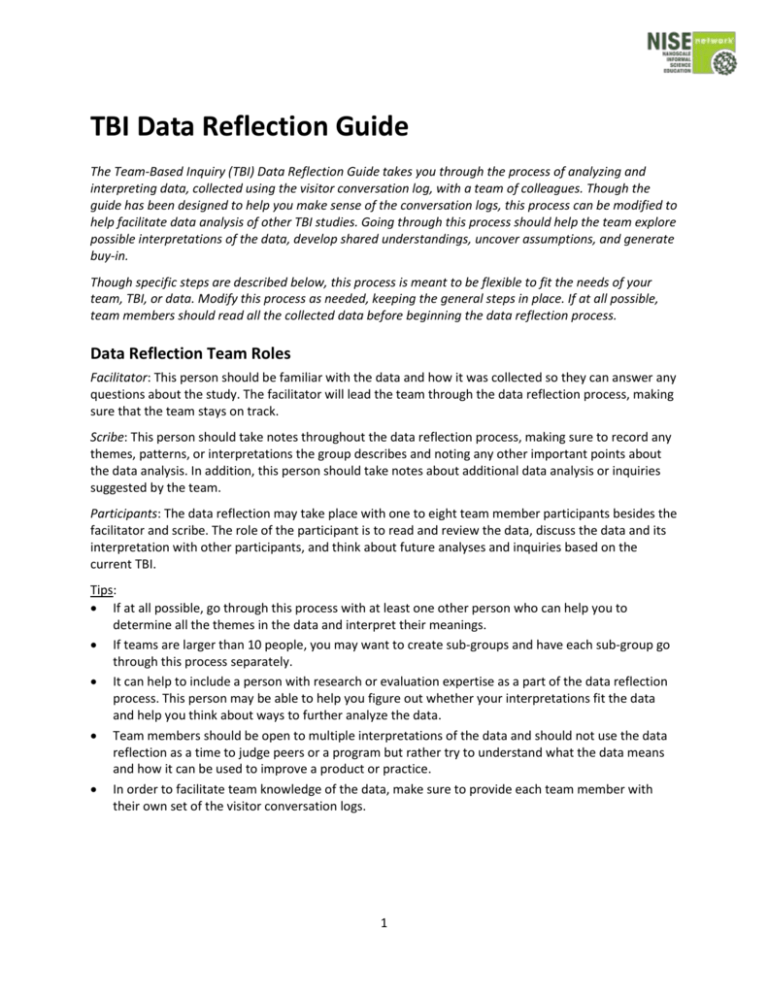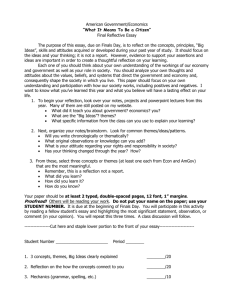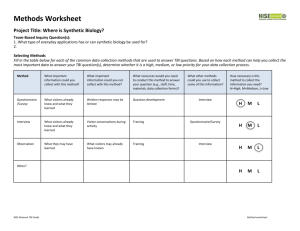TBI Data Reflection Guide
advertisement

TBI Data Reflection Guide The Team-Based Inquiry (TBI) Data Reflection Guide takes you through the process of analyzing and interpreting data, collected using the visitor conversation log, with a team of colleagues. Though the guide has been designed to help you make sense of the conversation logs, this process can be modified to help facilitate data analysis of other TBI studies. Going through this process should help the team explore possible interpretations of the data, develop shared understandings, uncover assumptions, and generate buy-in. Though specific steps are described below, this process is meant to be flexible to fit the needs of your team, TBI, or data. Modify this process as needed, keeping the general steps in place. If at all possible, team members should read all the collected data before beginning the data reflection process. Data Reflection Team Roles Facilitator: This person should be familiar with the data and how it was collected so they can answer any questions about the study. The facilitator will lead the team through the data reflection process, making sure that the team stays on track. Scribe: This person should take notes throughout the data reflection process, making sure to record any themes, patterns, or interpretations the group describes and noting any other important points about the data analysis. In addition, this person should take notes about additional data analysis or inquiries suggested by the team. Participants: The data reflection may take place with one to eight team member participants besides the facilitator and scribe. The role of the participant is to read and review the data, discuss the data and its interpretation with other participants, and think about future analyses and inquiries based on the current TBI. Tips: If at all possible, go through this process with at least one other person who can help you to determine all the themes in the data and interpret their meanings. If teams are larger than 10 people, you may want to create sub-groups and have each sub-group go through this process separately. It can help to include a person with research or evaluation expertise as a part of the data reflection process. This person may be able to help you figure out whether your interpretations fit the data and help you think about ways to further analyze the data. Team members should be open to multiple interpretations of the data and should not use the data reflection as a time to judge peers or a program but rather try to understand what the data means and how it can be used to improve a product or practice. In order to facilitate team knowledge of the data, make sure to provide each team member with their own set of the visitor conversation logs. 1 Step 1: Describe and Clarify a. The TBI question(s) should be written on a board or read out loud. b. Describe the context of the nano and society activity. What conversation goals were you focusing on when collecting the Visitor Conversation Logs? Where and when was the data collected? What, if anything, was unusual or unique about the way you implemented the conversation? c. Discuss the goals of the TBI and the data discussion. (What are you hoping to learn about your practice? What do you want to explore within the data?) d. Give group members a chance to ask clarifying questions. Tips: If you have a large amount of data, you may want to split your Data Reflection into multiple discussions, each of which focus on a smaller TBI question that only covers a portion of the data. Some possible TBI questions for the Nano & Society activities include, “How can we improve facilitation skills in the conversational approach?” or “How do we improve visitor engagement in nano and society conversations?” Step 2: Observe and Discuss a. If they don’t already have them, hand out copies of the visitor conversation logs to the team members. b. Give the team a chance to review the visitor conversation logs, even if they received them ahead of time. c. Ask the group to describe pieces of data within the visitor conversation logs that they think are interesting or important. d. Encourage group members to refer to data directly and quote information from the visitor conversation logs to illustrate their points. Tips: If the team starts to describe themes or patterns during this step, this is okay. Note these comments for use during the next data reflection step and continue to ask participants to describe one piece of interesting/important data. Remind the group that the purpose of this step is to help uncover the data that are most interesting/important to the TBI question before moving on to analysis. If you have limited time, pick a subset of your team members to describe a piece of data. To facilitate this step, provide a copy of all the visitor conversation logs to each team member. Step 3: Immerse and Notice a. Ask each group member to describe a theme or pattern from multiple visitor conversation logs. (What strategies appeared to work well in promoting conversation for more than one visitor group? What strategies appeared to not work well in promoting conversation with more than one group?) b. Remind group members that themes should relate to the TBI question(s), and encourage each participant to describe a new theme or pattern. c. List each theme on a board or take notes to record them. d. Continue this process until the team feels all possible themes or patterns have been described. 2 Step 4: Categorize and Explain a. Sort the data by each theme one at a time. It is fine if some visitor conversation logs are included in multiple themes. b. As needed, clarify and rethink themes as the group discusses which visitor conversation logs should go in each theme. (Are the sorted data really related, or should some be removed? Should the theme be renamed? Should themes be split or combined with any other themes?) c. After deciding on the visitor conversation logs that should be included within each theme, try to explain what these data mean. (What explanations are there for the presence of the theme? What are alternative explanations? If there are conflicting themes, how can they be explained?). d. After counting the number of cards within each of the themes, ask the group: What themes best represent the data and will help us answer the TBI question(s)? Tips: This step is likely to take the longest, so make sure to leave sufficient time. If you have limited time, sort the data only for the most important theme(s). Data can be sorted for other themes by a smaller group at a later time. Don't over interpret the data! Try not to infer meaning beyond what is written on each piece of data. However, some subjective judgment may be required to decide which data are related. Step 5: Reflect a. List group member findings on a board, or read them out loud. b. Ask group members to describe the implications of the data for future work. (Which facilitation strategies are effective at fostering visitor engagement at this nano and society activity?) c. Ask group members to discuss possible questions for future inquiry. (What other questions do you have about the nano and society activity or conversational interpretation strategies that could be explored through further TBI? Tip: If you have limited time, focus this discussion on potential changes to the program or practice instead of future TBI. This project was supported by the National Science Foundation under Award No. 0940143. Any opinions, findings, and conclusions or recommendations expressed in this program are those of the author and do not necessarily reflect the views of the Foundation. Copyright 2012, Museum of Science, Boston, MA. Created in collaboration with Science Museum of Minnesota, Oregon Museum of Science and Industry, Sciencenter, and New York Hall of Science. 3






